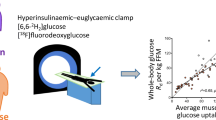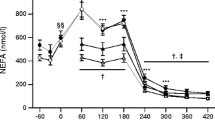Summary
We investigated the response of the glucose transport system to insulin, in the presence of ambient glucose concentrations, in isolated skeletal muscle from seven patients with non-insulin-dependent diabetes mellitus (NIDDM) (age, 55±3 years, BMI 27.4±1.8 kg/m2) and seven healthy control subjects (age, 54±3 years, BMI 26.5±1.1 kg/m2). Insulin-mediated whole body glucose utilization was similar between the groups when studied in the presence of ambient glucose concentrations (approximately 10 mmol/l for the NIDDM patients and 5 mmol/l for the control subjects). Samples were obtained from the vastus lateralis muscle, by means of an open muscle biopsy procedure, before and after a 40-min insulin infusion. An increase in serum insulin levels from 54±12 to 588±42 pmol/l, induced a 1.6±0.2-fold increase in glucose transporter protein (GLUT4) in skeletal muscle plasma membranes obtained from the control subjects (p<0.05), whereas no significant increase was noted in plasma membrane fractions prepared from NIDDM muscles, despite a similar increase in serum insulin levels. At concentrations of 5 mmol/l 3-O-methylglucose in vitro, insulin (600 pmol/l) induced a 2.2-fold (p<0.05) increase in glucose transport in NIDDM muscles and a 3.4-fold (p<0.001) increase in the control muscles. Insulin-stimulated 3-O-methylglucose transport was positively correlated with whole body insulin-mediated glucose uptake in all participants (r=0.78,p<0.001) and negatively correlated with fasting plasma glucose levels in the NIDDM subjects (r=0.93,p<0.001). Muscle fibre type distribution and capillarization were similar between the groups. Our results suggest that insulin-stimulated glucose transport in skeletal muscle from patients with NIDDM is down-regulated in the presence of hyperglycaemia. The increased flux of glucose as a consequence of hyperglycaemia may result in resistance to any further insulin-induced gain of GLUT4 at the level of the plasma membrane.
Similar content being viewed by others
Abbreviations
- NIDDM:
-
Non-insulin-dependent diabetes mellitus
- GLUT4:
-
insulin-regulatable glucose transporter protein
- KHB:
-
Krebs-Heinsleit bicarbonate buffer
- HEPES:
-
N-2-hydroxyethyl-piperazine-N-2-ethanesulphonic acid
- BSA:
-
bovine serum albumin
- ATPase:
-
adenosine triphosphatase
- PMSF:
-
phenylemthylsulphonyl fluoride.
References
DeFronzo RA, Bonadonna RC, Ferrannini E (1992) Pathogenesis of NIDDM. A balanced overview. Diabetes Care 15: 318–368
Fink RI, Wallace P, Brechtel G, Olefsky JM (1992) Evidence that glucose transport is rate-limiting for in vivo glucose uptake. Metabolism 41: 897–902
Bonadonna RC, Del Prato S, Saccomani MP et al. (1993) Transmembrane glucose transport in skeletal muscle of patients with non-insulin-dependent diabetes. J Clin Invest 92: 486–494
Dohm GL, Tapscott EB, Pories WJ et al. (1988) An in vitro human skeletal muscle preparation suitable for metabolic studies. Decreased insulin stimulation of glucose transport in muscle from morbidly obese and diabetic subjects. J Clin Invest 82: 486–494
Andréasson K, Galuska D, Thörne A, Sonnenfeld T, Wall-berg-Henriksson H (1991) Decreased insulin-stimulated 3-O-methylglucose transport in in vitro incubated muscle strips from type II diabetic subjects. Acta Physiol Scand 142: 255–260
Galuska D, Nolte LA, Zierath JR, Wallberg-Henriksson H (1994) Effect of metformin on insulin-stimulated glucose transport in isolated skeletal muscle obtained from patients with NIDDM. Diabetologia 37: 826–832
Pedersen O, Bak JF, Andersen PH et al. (1990) Evidence against altered expression of GLUT1 or GLUT4 in skeletal muscle of patients with obesity of NIDDM. Diabetes 39: 865–870
Handberg A, Vaag A, Damsbo P, Beck-Nielsen H, Vinten J (1990) Expression of insulin-regulatable glucose transporter in skeletal muscle from type 2 (non-insulin-dependent) diabetic patients. Diabetologia 33: 625–627
Garvey WT, Maianu L, Hancock JA, Golichowske AM, Baron A (1992) Evidence that glucose transport is rate-limiting for in vivo glucose uptake. Gene expression of GLUT4 in skeletal muscle from insulin-resistant patients with obesity, IGT, GDM, and NIDDM. Diabetes 41: 465–475
Vogt B, Muhlbacher C, Carrascosa J (1992) Subcellular distribution of GLUT4 in the skeletal muscle of lean type 2 (non-insulin-dependent) diabetic patients in the basal state. Diabetologia 35: 456–463
Lund S, Vestergaard H, Andersen PH, Schmitz O, Gotzsche H, Pedersen O (1993) GLUT-4 content in plasma membrane of muscle from patients with non-insulin-dependent diabetes mellitus. Am J Physiol 265:E889-E897
Gumá A, Zierath JR, Wallberg-Henriksson H, Klip A (1995) Insulin induces translocation of GLUT4 glucose transporters in human skeletal muscle. Am J Physiol 268:E613-E622
Henriksen JE, Alford F, Handberg A et al. (1994) Increased glucose effectiveness in normoglycemic but insulin-resistant relatives of patients with non-insulin-dependent diabetes mellitus. J Clin Invest 94: 1196–1204
Kelley DE, Mandarino LJ (1990) Hyperglycemia normalizes insulin-stimulated skeletal muscle glucose oxidation and storage in noninsulin-dependent diabetes mellitus. J Clin Invest 86: 1999–2007
Vaag A, Hother-Nielsen O, Skött P, Andersen P, Richter EA, Beck-Nielsen H (1992) Effects of acute hyperglycemia on glucose metabolism in skeletal muscle in IDDM patients. Diabetes 41: 174–182
Mandarino LJ, Consoli A, Jain A, Kelley D (1993) Differential regulation of intracellular glucose metabolism by glucose and insulin in human muscle. Am J Physiol 265:E898-E905
Hother-Nielsen O, Vaag A, Skött P, Beck-Nielsen H (1993) Effect of hyperglycemia per se on glucose turnover rates in patients with insulin-dependent diabetes. Metabolism 42: 86–93
Farrace S, Rossetti L (1992) Hyperglycemia markedly enhances skeletal muscle glycogen synthase activity in diabetic, but not in normal conscious rats. Diabetes 41: 1453–1463
Zierath JR, Galuska D, Nolte LA, Thörne A, Smedegaard Kristensen J, Wallberg-Henriksson H (1994) Effects of glycaemia on glucose transport in isolated skeletal muscle from patients with NIDDM: in vitro reversal of muscular insulin resistance. Diabetologia 37: 270–277
Henriksen EJ, Bourey RE, Rodnick KJ, Koranyi L, Permutt MA, Holloszy JO (1990) Glucose transporter protein content and glucose transport capacity in rat skeletal muscles. Am J Physiol 259:E593-E598
Henriksen EJ, Holloszy JO (1991) Effect of diffusion distance on measurement of rat skeletal muscle glucose transport in vitro. Acta Physiol Scand 143: 381–386
Hickey MS, Carey JO, Azevedo JL et al. (1995) Skeletal muscle fiber type composition is related to adiposity and in vitro glucose transport rate in humans. Am J Physiol 268:E453-E457
Zierath JR, Galuska D, Engström Å, et al. (1992) Human islet amyloid polypeptide at pharmacological levels inhibits insulin and phorbol ester-stimulated glucose transport in in vitro incubated human skeletal muscle strips. Diabetologia 35: 26–31
DeFronzo RA, Tobin JD, Andres R (1979) Glucose clamp technique: a method for quantifying insulin secretion and resistance. Am J Physiol 237:E214-E223
Krebs HA, Henseleit K (1932) Untersuchungen über die Harnstoffbildung im Tierköprper. Hoppe-Seyler’s Z Physiol Chem 210: 33–66
Henriksson KG (1979) “Semi-open” muscle biopsy technique. Acta Neurol Scand 59: 317–323
Zierath JR (1995) In vitro studies of human skeletal muscle: hormonal and metabolic regulation of glucose transport. Acta Phys Scand 155 [Suppl 626] 11–96
Wallberg-Henriksson H, Zetan N, Henriksson J (1987) Reversibility of decreased glucose transport capacity in diabetic muscle with in vitro incubation. Insulin is not required. J Biol Chem 262: 7665–7671
Bradford MM (1976) A rapid and sensitive method for the quantification of microgram quantities of protein utilizing the principles of protein-dye binding. Anal Biochem 72: 248–254
Wallberg-Henriksson H, Gunnarsson R, Henriksson J, Östman J, Wahren J (1984) Influence of physical training on formation of muscle capillaries in type I diabetes. Diabetes 33: 851–857
Hjemdahl P, Daleskog M, Kahan T (1979) Determination of plasma catecholamines by high performance liquid chromatography with electrochemical detection: comparison with a radioenzymatic method. Life Sciences 25: 131–138
Wallberg-Henriksson H, Gunnarsson R, Henriksson J et al. (1982) Increased peripheral insulin sensitivity and muscle mitochondrial enzymes but unchanged blood glucose control in type 1 diabetes after physical training. Diabetes 31: 1044–1050
Choi WH, O’Rahilly S, Buse JB et al. (1991) Molecular scanning of insulin-responsive glucose transporter (GLUT4) gene in NIDDM subjects Diabetes 40: 1712–1718
Buse JB, Yasuda K, Lay TP et al. (1992) Human GLUT4/muscle-fat glucose-transporter gene. Diabetes 41: 1436–1445
Bjorbæk C, Echwald SM, Hubricht P et al. (1995) Genetic variants in promoters and coding regions of the muscle glycogen synthase and the insulin-responsive GLUT4 genes in NIDDM. Diabetes 43: 976–983
Müller HK, Kellerer M, Ermel B et al. (1991) Prevention by protein kinase C inhibitors of glucose-induced insulin-receptor tyrosine kinase resistance in rat fat cells. Diabetes 40: 1440–1447
Berti L, Mosthaf L, Kroder G et al. (1994) Glucose induced translocation of protein kinase C isoforms in rat-1 fibroblasts is paralleled by inhibition of the insulin receptor tyrosine kinase. J Biol Chem 269: 3381–3386
Galante P, Mosthaf L, Kellerer M et al. (1995) Acute hyperglycemia provides an insulin-independent inducer for GLUT4 translocation in C2C12 myotubes and rat skeletal muscle. Diabetes 44: 646–651
Nolte LA, Rincón J, Odegaard Wahlström E, Craig BW, Zierath JR, Wallberg-Henriksson H (1995) Hyperglycemia activates glucose transport in rat skeletal muscle via a Ca2+ -dependent mechanism. Diabetes 44: 1345–1348
Rossetti L, Smith D, Shulman GI, Papachristou D, DeFronzo RA (1987) Correction of hyperglycemia with phlorizin normalizes tissue sensitivity to insulin in diabetic rats. J Clin Invest 79: 1510–1515
Yki-Järvinen H, Helve E, Koivisto VA (1987) Hyperglycemia decreases glucose uptake in type I diabetes. Diabetes 36: 892–896
Richter EA, Hansen BF, Hensen SA (1988) Glucose-induced insulin resistance of skeletal-muscle glucose transport and uptake. Biochem J 252: 733–737
Gulve EA, Ren J-M, Marshall BA et al. (1994) Glucose transport activity in skeletal muscle from transgenic mice overexpressing GLUT1. J Biol Chem 269: 18266–18370
Laakso M, Edelman SV, Brechtel G, Baron AD (1992) Impaired insulin-mediated skeletal muscle blood flow in patients with NIDDM. Diabetes 41: 1076–1083
Nuutila P, Koivisto VA, Knuuti J et al. (1992) Glucose-free fatty acid cycle operates in human heart and skeletal muscle in vivo. J Clin Invest 89: 1767–1774
Boström M, Nie Z, Goertz G, Henriksson J, Wallberg-Henriksson H (1989) Indirect effect of catecholamines on development of insulin resistance in skeletal muscle from diabetic rats. Diabetes 38: 906–910
Zhang Y, Proenca R, Maffei M, Barone M, Leopold L, Friedman JM (1994) Positional cloning of the mouse obese gene and its human homologue. Nature 372: 425–432
Robinson KA, Sens DA, Buse MG (1993) Pre-exposure to glucosamine induces insulin resistance of glucose transport and glycogen synthesis in isolated rat skeletal muscles. Diabetes 42: 1333–1346
Yki-Järvinen H, Daniels MC, Virkamäki A, Mäkimattila S, DeFronzo RA, McLain D (1996) Increased glutamine:fructose 6-phosphate amidotransferase activity in skeletal muscle of patients with NIDDM. Diabetes 45: 302–307
Mårin P, Andersson B, Krotkiewski M, Björntorp P (1994) Muscle fiber composition and capillary density in women and men with NIDDM. Diabetes Care 17: 382–386
Author information
Authors and Affiliations
Rights and permissions
About this article
Cite this article
Zierath, J.R., He, L., Gumà, A. et al. Insulin action on glucose transport and plasma membrane GLUT4 content in skeletal muscle from patients with NIDDM. Diabetologia 39, 1180–1189 (1996). https://doi.org/10.1007/BF02658504
Received:
Revised:
Published:
Issue Date:
DOI: https://doi.org/10.1007/BF02658504




